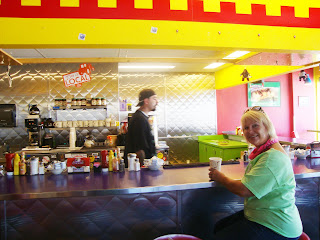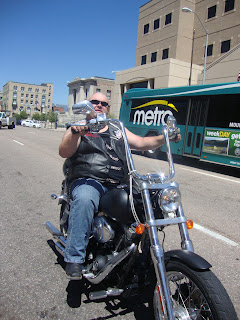First you run them under cold water, then you trim off their little faces and next you pull their lungs out!
EEEEK!!! Tender loving words re-iterated by my Mom, while teaching me the process when I was a kid.
"How to clean a Soft Shell Crab"!
So do you know how to clean the beautiful, delicate Soft Shell Blue Crab? Better yet, have you ever cooked a few and savored its deliciousness? An important part of the process to stack the perfect Soft Shell Crab Sandwich you need to slice a big, fat juicy tomato in a thick kinda way, then slather on some mayo and slap it on - yes.."Wonder Bread". This is nothing but pure joy!
Such a beautiful Sea Creature. I love to saute' them in butter til it's shell is golden crisp. No flour - just sear that gorgeous velvety soft crabby-ness, this my friends is a delicacy extraordinare!
Well anyway, I was scanning the fresh Seafood Market in my neighborhood the other day and my eyes fell upon 3 perfectly gorgeous little Soft Shell Crabs. I asked to touch them...yes, I did ask that question.
I proposed a deal to the Store Clerk, I told her I would just touch with the tip of my finger so I could feel if it was actually a SOFT CRAB, and I would use a piece of wax paper as the health safety barrier. One small bit of pressure on this little Darlin' and it was very evident.. we had scored the Mega Score! The perfect Soft Shell Crab, so exciting. Eighteen dollars later, gave me 3 little Soft Shells to go... so worth every penny.
The Crispy Soft Shell Crab Recipe:
A couple of Soft Shell Crabs - cleaned and ready to go
A dash of Old Bay Seasoning
3 Tblsp. Butter
Red Tomato
Your favorite Mayo
Wonder Bread
Over medium heat add the butter to a large saute' pan. Allow the butter to melt until bubbly. While waiting clean your Soft Shell Crabs, then rinse under cold water, dab dry with paper towels, then dust with just a bit of Old Bay . Once the butter is bubbly place the crabs in the saute pan, over medium heat. Cook about two minutes on each side or until crisp. Place the crabs on the white bread that holds the mayo and tomato.. Cut sandwich in half and take a big bite of those little tender Feeler legs that will be dangling off your bread.
OMG DELICIOUS!!
Read onward for some interesting INFO about SOFT SHELL CRABS!!.
SOFT SHELL CRAB PIX in the "alive state". As you can imagine holding a hard shelled crab in bare hands could be a bit painful! When it's a Soft Shell Crab their exterior is as soft as velvet.
Thanks About.com for a great reference picture.
So again, I'm giving you INFO from a researched source which was BLUECRAB.COM. These folks made it
oh so easy for me to explain!
Blue crabs periodically shed their smaller shells through a process known as molting. The soft-shell is the blue crab in its molted state which is abundant in supply from late spring to early fall
Blue crabs are invertebrates meaning they lack a spinal column. Instead, the blue crab has a rigid exoskeleton (hard shell.) The shell grows in discrete stages interspersed by molting, but the growth of internal tissue is more continuous. In order for the crab to grow larger, it must periodically shed its smaller shell through a process known as molting. Early in its molting cycle the crab slowly begins to form a new soft shell underneath its existing hard shell.
When a blue crab has grown sufficiently to require a larger shell, the following events occur
Molting hormones are released.
** This time frame is known as the "Peeler" stage. Hence in this stage they are called PEELER CRABS
- The hypodermis detaches from the existing hard shell. The hypodermis is a layer of cells directly beneath the shell.
- The hypodermis produces enzymes which begin to dissolve the shell components. Much of the existing shell is recycled causing it to become thin. Inorganic salts are resorbed from the shell and stored internally.
- A new inner soft shell slowly forms underneath the existing shell. When this new shell has fully formed, the crab will be ready to molt.
- The crab stops eating and seeks shelter in order to avoid predation. During this process the crab is highly vulnerable to predators, including the two-legged variety!
This time frame, is known as the "Buster" stage. Hence in this stage they are called BUSTER CRABS
- The hypodermis detaches from the existing hard shell. The hypodermis is a layer
- The crab rapidly absorbs water which causes its tissues to swell and split the old shell open across the back between the lateral spines. Fracture planes in the claws split open to allow the claws to be pulled through.
- The crab begins the slow, arduous process of backing out of its old shell, which is then discarded.
- The newly molted crab pumps water into its tissues in order to inflate the shell to its new size. The new shell will be roughly one-third larger (33%) than the old shell. The new shell reaches its full size within six hours after molting.
This time frame is known as the "Soft Shell Stage". Hence in this stage they are called SOFT SHELL CRABS! YEAAA!
- The salvaged inorganic salts are rapidly re deposited to help thicken and harden the new shell will only harden in water (the hardening process stops if the crab is removed from the water) and will take approximately two to four days to fully harden.
Over time, as the crab slowly grows inside its new shell, tissue water is replaced with protein. Once there is no more room left to grow inside this shell, the whole molting process starts over again.
Note that some people mistakenly believe that a soft crab is completely different species of crab. As you have just learned, this is not true.
Also note that many people believe that a full moon yields larger catches of soft crabs This belief is reinforced by the fact that most commercial harvesters claim to see an increase in peeler/soft crab abundance before and after a full moon.















